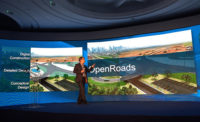The contractor turned to laser scanning to help it address the challenge. It uses Trimble Robotic Total Stations for control, a FARO Focus 3D laser scanner to capture the room's floor geometry, FARO Scene software for point-cloud registration, FARO Webshare for hosting and access to the point clouds, and Trimble Realworks for scan processing. Then, it uses Autodesk's Civil 3D with custom plug-ins to map the laser-scanned floor topography and analyze the point-cloud data. AutoCAD is used for the structural-survey and beam-deflection plans.
Handheld Scanner
DotProduct's DP1-7 handheld 3D scanner is a true mashup of consumer hardware, comprising a handle-mounted Nexus 7 tablet PC mated with a Microsoft Kinect camera and operated by the company's powerful "phi.3D" purpose-built software for on-the-spot processing of the captured data.
"It's a mobile 3D capture device that is easy to use, with real-time data processing on a tablet," says DotProduct co-founder Mark Klusza. "We built it to bridge that gap between the perfect world of CAD to the real world of construction. It's cheap and easy to use. You don't need a special team, and you can see your results in the field."
Although the Kinect camera was engineered as a gaming device to capture the human body's gestures and use sophisticated software to turn those motions into gamer interaction, the hardware itself can be re-purposed. It consists of an infrared laser, a set of sensors to read depth and capture 3D data, a RGB camera to capture natural-color, visible-light information and a powerful "system on a chip" to process the data. Klusza, like many other inventors, has been charmed by the possibilities of converting the Kinect from gaming to a practical, handheld laser-scanning tool. With the software DotProduct has developed and the growing power of tablet PC technology, it looks like the company has succeeded.
A preproduction version was demonstrated at a recent SPAR laser-scanning conference in Colorado Springs, Colo., in April. "We have a "First Movers" program, which is the first 100 units," says DotProduct CEO Brian Ahern. The vendor offered a $1,000 discount off the $4,950 price. "These are not orders yet, but these are people that have requested to be on that list," Ahern says. "They must buy within one month of release. The list was almost full just from SPAR."
"We asked visitors to our booth to give us a business card," Ahern says. Within two hours, he says he had five people give him credit cards instead. "They were willing to pay right then and there. We have 90 names on the list now," he says.
Klusza adds, "Our goal is ubiquitous use—not just those people using laser scanners today, not just specialty providers. [Our goal is] to get 3D imaging into the hands of people who aren't using it today because of limits of cost and time and complexity."
"There is a combination of technology here that is facilitating a new market space, a new application area," says Ralph Rio, a technology analyst with the ARC Advisory Group, which counsels clients on technology investments. "I could see huge benefits in industrial applications."
"The thing that's really great about this is the dimensional accuracy compared to a camera," adds Rio. "I would definitely recommend people pilot it. It's a very low-risk pilot project. You're not sending someone to school but just using it. This is going to be a very rapidly emerging technology because it's based on consumer-level devices and software. It's going to be very easy for a fast ramp up and adoption."











Post a comment to this article
Report Abusive Comment